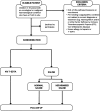Preventing adverse events during paediatric cancer treatment: protocol for a multi-site hybrid randomised controlled trial of catheter lock solutions (the CLOCK trial)
- PMID: 38986559
- PMCID: PMC11243282
- DOI: 10.1136/bmjopen-2024-085637
Preventing adverse events during paediatric cancer treatment: protocol for a multi-site hybrid randomised controlled trial of catheter lock solutions (the CLOCK trial)
Abstract
Introduction: Central venous access devices (CVADs) are commonly used for the treatment of paediatric cancer patients. Catheter locking is a routine intervention that prevents CVAD-associated adverse events, such as infection, occlusion and thrombosis. While laboratory and clinical data are promising, tetra-EDTA (T-EDTA) has yet to be rigorously evaluated or introduced in cancer care as a catheter lock.
Methods and analysis: This is a protocol for a two-arm, superiority type 1 hybrid effectiveness-implementation randomised controlled trial conducted at seven hospitals across Australia and New Zealand. Randomisation will be in a 3:2 ratio between the saline (heparinised saline and normal saline) and T-EDTA groups, with randomly varied blocks of size 10 or 20 and stratification by (1) healthcare facility; (2) CVAD type and (3) duration of dwell since insertion. Within the saline group, there will be a random allocation between normal and heparin saline. Participants can be re-recruited and randomised on insertion of a new CVAD. Primary outcome for effectiveness will be a composite of CVAD-associated bloodstream infections (CABSI), CVAD-associated thrombosis or CVAD occlusion during CVAD dwell or at removal. Secondary outcomes will include CABSI, CVAD-associated-thrombosis, CVAD failure, incidental asymptomatic CVAD-associated-thrombosis, other adverse events, health-related quality of life, healthcare costs and mortality. To achieve 90% power (alpha=0.05) for the primary outcome, data from 720 recruitments are required. A mixed-methods approach will be employed to explore implementation contexts from the perspective of clinicians and healthcare purchasers.
Ethics and dissemination: Ethics approval has been provided by Children's Health Queensland Hospital and Health Service Human Research Ethics Committee (HREC) (HREC/22/QCHQ/81744) and the University of Queensland HREC (2022/HE000196) with subsequent governance approval at all sites. Informed consent is required from the substitute decision-maker or legal guardian prior to participation. In addition, consent may also be obtained from mature minors, depending on the legislative requirements of the study site. The primary trial and substudies will be written by the investigators and published in peer-reviewed journals. The findings will also be disseminated through local health and clinical trial networks by investigators and presented at conferences.
Trial registration number: ACTRN12622000499785.
Keywords: HAEMATOLOGY; ONCOLOGY; PAEDIATRICS; Randomized Controlled Trial.
© Author(s) (or their employer(s)) 2024. Re-use permitted under CC BY-NC. No commercial re-use. See rights and permissions. Published by BMJ.
Conflict of interest statement
Competing interests: None declared.
Figures
Similar articles
-
Control of Line Complications with KiteLock (CLiCK) in the critical care unit: study protocol for a multi-center, cluster-randomized, double-blinded, crossover trial investigating the effect of a novel locking fluid on central line complications in the critical care population.Trials. 2022 Aug 30;23(1):719. doi: 10.1186/s13063-022-06671-5. Trials. 2022. PMID: 36042488 Free PMC article.
-
Central venous Access device SeCurement And Dressing Effectiveness (CASCADE) in paediatrics: protocol for pilot randomised controlled trials.BMJ Open. 2016 Jun 3;6(6):e011197. doi: 10.1136/bmjopen-2016-011197. BMJ Open. 2016. PMID: 27259529 Free PMC article. Clinical Trial.
-
Routine Catheter Lock Solutions in Pediatric Cancer Care: A Pilot Randomized Controlled Trial of Heparin vs Saline.Cancer Nurs. 2022 Nov-Dec 01;45(6):438-446. doi: 10.1097/NCC.0000000000001053. Epub 2022 Feb 5. Cancer Nurs. 2022. PMID: 35131974 Free PMC article. Clinical Trial.
-
Heparin versus normal saline locking for prevention of occlusion, catheter-related infections and thrombosis in central venous catheter in adults: Overview of systematic reviews.J Vasc Access. 2024 Nov;25(6):1741-1748. doi: 10.1177/11297298221103201. Epub 2022 Jun 10. J Vasc Access. 2024. PMID: 35686498
-
Normal saline (0.9% sodium chloride) versus heparin intermittent flushing for the prevention of occlusion in long-term central venous catheters in infants and children.Cochrane Database Syst Rev. 2020 Apr 30;4(4):CD010996. doi: 10.1002/14651858.CD010996.pub3. Cochrane Database Syst Rev. 2020. PMID: 32352563 Free PMC article.
References
-
- Hofmann S, Goedeke J, König TT, et al. Multivariate analysis on complications of central venous access devices in children with cancer and severe disease influenced by catheter tip position and vessel insertion site (A STROBE-compliant study) Surg Oncol. 2020;34:17–23. doi: 10.1016/j.suronc.2020.02.009. - DOI - PubMed
-
- Forbrigger Z, Kulkarni K. Use of tissue plasminogen activator as a surrogate measure for central venous catheter dysfunction and survival outcome in children with cancer: a population-based retrospective cohort study. Pediatr Hematol Oncol. 2020;37:554–60. doi: 10.1080/08880018.2020.1762810. - DOI - PubMed
Publication types
MeSH terms
Substances
LinkOut - more resources
Full Text Sources
Medical

